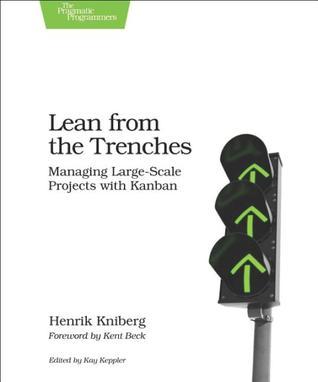
Lean from the Trenches
Book genres
Management, Business, Nonfiction, Software, Programming, Technology, Leadership, Computer Science, Technical, Computers
Topics
Lean Startup, Lean Development, Business Planning, Avoid Micromanagement
Find out how the Swedish police combined XP, Scrum, and Kanban in a 60-person project. From start to finish, you`ll see how to deliver a successful product using Lean principles.
We start with an organization in desperate need of a new way of doing things and finish with a group of sixty, all working in sync to develop a scalable, complex system. You`ll walk through the project step by step, from customer engagement, to the daily "cocktail party," version control, bug tracking, and release. In this honest look at what works--and what doesn`t--you`ll find out how to:
Make quality everyone`s business, not just the testers. Keep everyone moving in the same direction without micromanagement. Use simple and powerful metrics to aid in planning and process improvement. Balance between low-level feature focus and high-level system focus.
You`ll be ready to jump into the trenches and streamline your own development process.
Contents
Foreword
Preface
PART I: HOW WE WORK
1. About the Project
1.1 Timeline 5
1.2 How We Sliced the Elephant 6
1.3 How We Involved the Customer 7
2. Structuring the Teams
3. Attending the Daily Cocktail Party
3.1 First Tier: Feature Team Daily Stand-up
3.2 Second Tier: Sync Meetings per Specialty
3.3 Third Tier: Project Sync Meeting
4. The Project Board
4.1 Our Cadences
4.2 How We Handle Urgent Issues and Impediments
5. Scaling the Kanban Boards
6. Tracking the High-Level Goal
7. Defining Ready and Done
7.1 Ready for Development
7.2 Ready for System Test
7.3 How This Improved Collaboration
8. Handling Tech Stories
8.1 Example 1: System Test Bottleneck
8.2 Example 2: Day Before the Release
8.3 Example 3: The 7-Meter Class
9. Handling Bugs
9.1 Continuous System Test
9.2 Fix the Bugs Immediately
9.3 Why We Limit the Number of Bugs in the Bug Tracker
9.4 Visualizing Bugs
9.5 Preventing Recurring Bugs
10. Continuously Improving the Process
10.1 Team Retrospectives
10.2 Process Improvement Workshops
10.3 Managing the Rate of Change
11. Managing Work in Progress
11.1 Using WIP Limits
11.2 Why WIP Limits Apply Only to Features
12. Capturing and Using Process Metrics
12.1 Velocity (Features per Week)
12.2 Why We Don’t Use Story Points
12.3 Cycle Time (Weeks per Feature)
12.4 Cumulative Flow
12.5 Process Cycle Efficiency
13. Planning the Sprint and Release
13.1 Backlog Grooming
13.2 Selecting the Top Ten Features
13.3 Why We Moved Backlog Grooming Out of the Sprint Planning Meeting
13.4 Planning the Release
14. How We Do Version Control
14.1 No Junk on the Trunk
14.2 Team Branches
14.3 System Test Branch
15. Why We Use Only Physical Kanban Boards
16. What We Learned
16.1 Know Your Goal
16.2 Experiment
16.3 Embrace Failure
16.4 Solve Real Problems
16.5 Have Dedicated Change Agents
16.6 Involve People
PART II: A CLOSER LOOK AT THE TECHNIQUES
17. Agile and Lean in a Nutshell
17.1 Agile in a Nutshell
17.2 Lean in a Nutshell
17.3 Scrum in a Nutshell
17.4 XP in a Nutshell
17.5 Kanban in a Nutshell
18. Reducing the Test Automation Backlog
18.1 What to Do About It
18.2 How to Improve Test Coverage a Little Bit Each Iteration
18.3 Step 1: List Your Test Cases
18.4 Step 2: Classify Each Test
18.5 Step 3: Sort the List in Priority Order
18.6 Step 4: Automate a Few Tests Each Iteration
18.7 Does This Solve the Problem?
19. Sizing the Backlog with Planning Poker
19.1 Estimating Without Planning Poker
19.2 Estimating with Planning Poker
19.3 Special Cards
20. Cause-Effect Diagrams
20.1 Solve Problems, Not Symptoms
20.2 The Lean Problem-Solving Approach: A3 Thinking
20.3 How to Use Cause-Effect Diagrams
20.4 Example 1: Long Release Cycle
20.5 Example 2: Defects Released to Production
20.6 Example 3: Lack of Pair Programming
20.7 Example 4: Lots of Problems
20.8 Practical Issues: How to Create and Maintain the Diagrams
20.9 Pitfalls
20.10 Why Use Cause-Effect Diagrams?
21. Final Words
A1. Glossary: How We Avoid Buzzword Bingo
Index